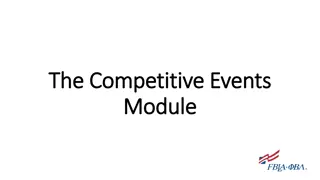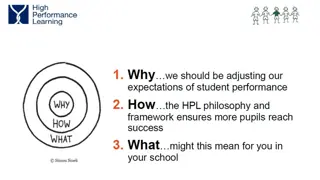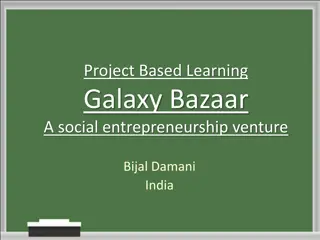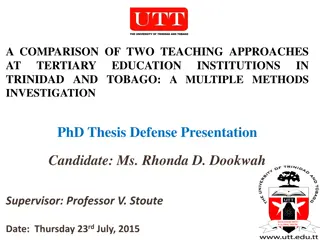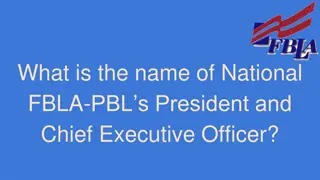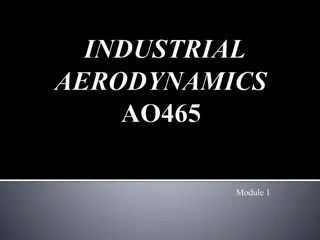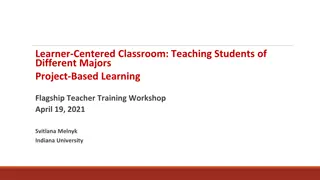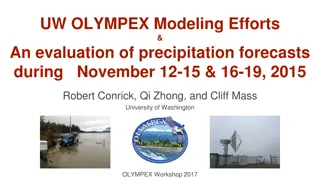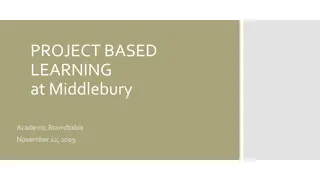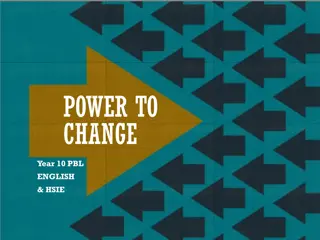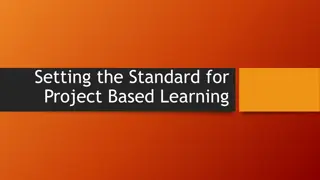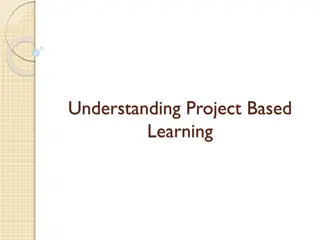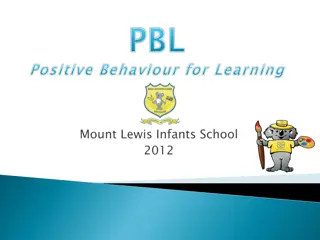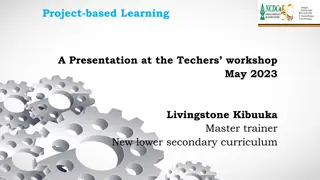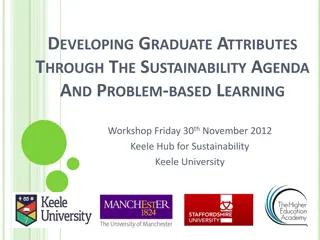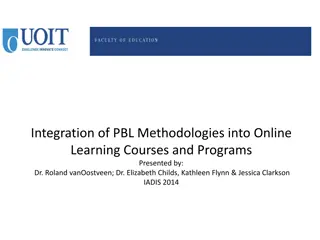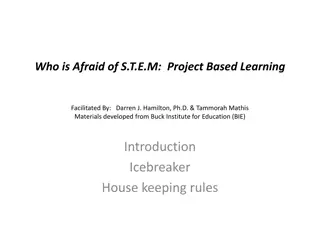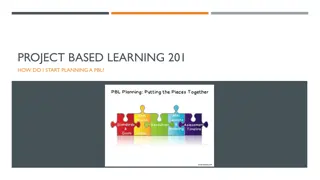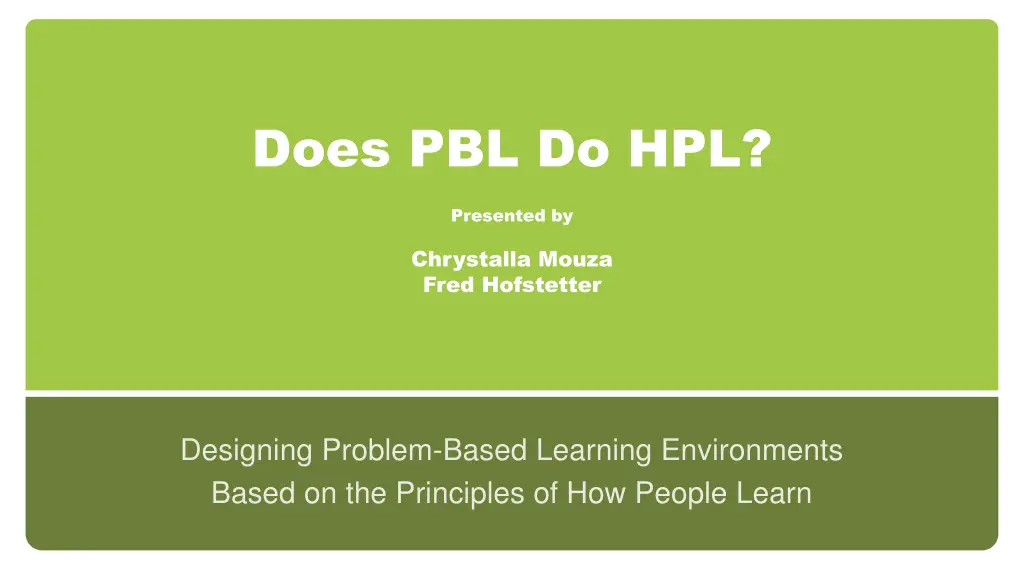
How Situated Learning Enhances Knowledge Acquisition
Explore the principles of situated learning and its impact on knowledge acquisition. Discover how context, activity, and social interaction shape learning experiences, moving beyond abstract knowledge to foster active learning environments that engage learners in meaningful ways.
Download Presentation

Please find below an Image/Link to download the presentation.
The content on the website is provided AS IS for your information and personal use only. It may not be sold, licensed, or shared on other websites without obtaining consent from the author. If you encounter any issues during the download, it is possible that the publisher has removed the file from their server.
You are allowed to download the files provided on this website for personal or commercial use, subject to the condition that they are used lawfully. All files are the property of their respective owners.
The content on the website is provided AS IS for your information and personal use only. It may not be sold, licensed, or shared on other websites without obtaining consent from the author.
E N D
Presentation Transcript
Does PBL Do HPL? Presented by Chrystalla Mouza Fred Hofstetter Designing Problem-Based Learning Environments Based on the Principles of How People Learn
The Problem of Inert Knowledge As early as 1929 Alfred North Whitehead argued that the way students learn many things in school produces "inert" knowledge knowledge that the student can use to answer items on a school test but which is not available when the student is trying to solve a problem requiring that knowledge.
Teaching Is Not Learning Contemporary theories about How People Learn argue that teaching abstractly out of context yields inert knowledge.
Addressing Inert Knowledge For knowledge to be active it should be acquired in learning environments that follow the principles of How People Learn. A landmark book from the National Research Council, How People Learn is freely available at www.nap.edu/ openbook.php? isbn=0309070368.
Situated Learning What are the principles of situated learning? Proponents of Situated Learning argue that learning as it normally occurs is a function of the activity, context and culture in which it occurs (i.e., it is situated). This contrasts with most classroom learning activities which involve knowledge which is abstract and out of context. Social interaction is a critical component of situated learning learners become involved in a "community of practice" which embodies certain beliefs and behaviors to be acquired (Lave).
Central Tenets of Situated Learning Cognition is: Situated the physical and social context in which an activity take place are an integral part of the activity; the activity is also an integral part of the learning that takes place within it. Situated learning requires the use of authentic activities. Social interactions with people are important and influence both what is learned and how is learned. By interacting with people learners get to become enculturated into the discourse and practices of a particular community. Distributed individuals rely on other people as well as artifacts and tools to perform a task.
Can PBL Do HPL? To what extent do Problem-Based Learning environments align with the principles of How People Learn? Can the principles of HPL enable PBL designers to create more effective learning environments? How do these principles inform the selection of tools to help PBL students and facilitators leverage these strategies? We constructed a matrix to help think about this and we need your help filling it out.
PBL HPL Strategy Tools Students form groups to discuss the problem and activate prior knowledge. People learn by connecting new information to concepts already learned. eLearning coaching protocols Feedback as learning system Mind mapping Just-in-time videos Take into account the learner s preexisting understandings and correct any faulty preconceptions in order to prevent future misunderstandings. Within their group, students develop hypotheses to frame the problem and, assisted by the facilitator, identify issues to be researched. People are motivated to learn when they can set their own goals and feel in control of their learning. Identify the zone within which the student is able to work and provide appropriate scaffolding. eLearning coaching protocols Feedback as learning system Students work individually to discover knowledge applicable to solving the problem. To learn how to reason, solve problems, and augment knowledge in a field of inquiry, people need to understand facts and ideas in the context of a conceptual framework that facilitates application to real- world problem solving. Enable students to study multiple examples of the concept at work in order to learn it in depth in authentic contexts. Discussion Forums Search & Discovery Chat Videoconferencing Blogs Wikis Mind mapping Checkpoints Students meet in groups to brainstorm solutions and consider the societal impact of alternate solutions to the problem. People are motivated to learn when they can reflect on their progress and feel increasingly useful in society. Include metacognitive supports that make visible the learner s reflections and enable the facilitator to provide scaffolding and guide revisions to improve student learning and reasoning.
Constructing the PBL-HPL Matrix The PBL-HPL Matrix aligns the process of PBL with the principles of How People Learn. Each row of the matrix concludes with a question about what tools can help PBL students and facilitators realize the great promise of the strategies we are suggesting here. We would like you to help by contributing ideas and suggesting tools in our AnswerGarden. While Fred presents the matrix, Chrystalla will monitor the AnswerGarden, which is available for you to participate here: https://answergarden.ch/view/243510
PBL HPL Strategy Tools Students form groups to discuss the problem and activate prior knowledge. People learn by connecting new information to concepts already learned. eLearning coaching protocols Feedback as learning system Mind mapping Just-in-time videos Take into account the learner s preexisting understandings and correct any faulty preconceptions in order to prevent future misunderstandings. Within their group, students develop hypotheses to frame the problem and, assisted by the facilitator, identify issues to be researched. People are motivated to learn when they can set their own goals and feel in control of their learning. Identify the zone within which the student is able to work and provide appropriate scaffolding. eLearning coaching protocols Feedback as learning system Students work individually to discover knowledge applicable to solving the problem. To learn how to reason, solve problems, and augment knowledge in a field of inquiry, people need to understand facts and ideas in the context of a conceptual framework that facilitates application to real- world problem solving. Enable students to study multiple examples of the concept at work in order to learn it in depth in authentic contexts. Discussion Forums Search & Discovery Chat Videoconferencing Students form groups to discuss the problem and activate prior knowledge. Blogs Wikis Mind mapping Checkpoints Students meet in groups to brainstorm solutions and consider the societal impact of alternate solutions to the problem. People are motivated to learn when they can reflect on their progress and feel increasingly useful in society. Include metacognitive supports that make visible the learner s reflections and enable the facilitator to provide scaffolding and guide revisions to improve student learning and reasoning.
PBL HPL Strategy Tools Students form groups to discuss the problem and activate prior knowledge. People learn by connecting new information to concepts already learned. eLearning coaching protocols Feedback as learning system Mind mapping Just-in-time videos Take into account the learner s preexisting understandings and correct any faulty preconceptions in order to prevent future misunderstandings. Within their group, students develop hypotheses to frame the problem and, assisted by the facilitator, identify issues to be researched. People are motivated to learn when they can set their own goals and feel in control of their learning. Identify the zone within which the student is able to work and provide appropriate scaffolding. eLearning coaching protocols Feedback as learning system Students work individually to discover knowledge applicable to solving the problem. To learn how to reason, solve problems, and augment knowledge in a field of inquiry, people need to understand facts and ideas in the context of a conceptual framework that facilitates application to real- world problem solving. the problem and, assisted by the facilitator, identify issues to be researched. Enable students to study multiple examples of the concept at work in order to learn it in depth in authentic contexts. Discussion Forums Search & Discovery Chat Videoconferencing Within their group, students develop hypotheses to frame Blogs Wikis Mind mapping Checkpoints Students meet in groups to brainstorm solutions and consider the societal impact of alternate solutions to the problem. People are motivated to learn when they can reflect on their progress and feel increasingly useful in society. Include metacognitive supports that make visible the learner s reflections and enable the facilitator to provide scaffolding and guide revisions to improve student learning and reasoning.
PBL HPL Strategy Tools Students form groups to discuss the problem and activate prior knowledge. People learn by connecting new information to concepts already learned. eLearning coaching protocols Feedback as learning system Mind mapping Just-in-time videos Take into account the learner s preexisting understandings and correct any faulty preconceptions in order to prevent future misunderstandings. Within their group, students develop hypotheses to frame the problem and, assisted by the facilitator, identify issues to be researched. People are motivated to learn when they can set their own goals and feel in control of their learning. Identify the zone within which the student is able to work and provide appropriate scaffolding. eLearning coaching protocols Feedback as learning system Students work individually to discover knowledge applicable to solving the problem. To learn how to reason, solve problems, and augment knowledge in a field of inquiry, people need to understand facts and ideas in the context of a conceptual framework that facilitates application to real- world problem solving. discover knowledge applicable to solving the problem. Enable students to study multiple examples of the concept at work in order to learn it in depth in authentic contexts. Discussion Forums Search & Discovery Chat Videoconferencing Students work individually to Blogs Wikis Mind mapping Checkpoints Students meet in groups to brainstorm solutions and consider the societal impact of alternate solutions to the problem. People are motivated to learn when they can reflect on their progress and feel increasingly useful in society. Include metacognitive supports that make visible the learner s reflections and enable the facilitator to provide scaffolding and guide revisions to improve student learning and reasoning.
PBL HPL Strategy Tools Students form groups to discuss the problem and activate prior knowledge. People learn by connecting new information to concepts already learned. Students meet in groups to brainstorm solutions and consider the societal impact of alternate solutions to the problem. eLearning coaching protocols Feedback as learning system Mind mapping Just-in-time videos Take into account the learner s preexisting understandings and correct any faulty preconceptions in order to prevent future misunderstandings. Within their group, students develop hypotheses to frame the problem and, assisted by the facilitator, identify issues to be researched. People are motivated to learn when they can set their own goals and feel in control of their learning. Identify the zone within which the student is able to work and provide appropriate scaffolding. eLearning coaching protocols Feedback as learning system Students work individually to discover knowledge applicable to solving the problem. To learn how to reason, solve problems, and augment knowledge in a field of inquiry, people need to understand facts and ideas in the context of a conceptual framework that facilitates application to real- world problem solving. Enable students to study multiple examples of the concept at work in order to learn it in depth in authentic contexts. Discussion Forums Search & Discovery Chat Videoconferencing Blogs Wikis Mind mapping Checkpoints Students meet in groups to brainstorm solutions and consider the societal impact of alternate solutions to the problem. People are motivated to learn when they can reflect on their progress and feel increasingly useful in society. Include metacognitive supports that make visible the learner s reflections and enable the facilitator to provide scaffolding and guide revisions to improve student learning and reasoning.
PBL HPL Strategy Tools Students form groups to discuss the problem and activate prior knowledge. People learn by connecting new information to concepts already learned. eLearning coaching protocols Feedback as learning system Mind mapping Just-in-time videos Take into account the learner s preexisting understandings and correct any faulty preconceptions in order to prevent future misunderstandings. Within their group, students develop hypotheses to frame the problem and, assisted by the facilitator, identify issues to be researched. People are motivated to learn when they can set their own goals and feel in control of their learning. Identify the zone within which the student is able to work and provide appropriate scaffolding. eLearning coaching protocols Feedback as learning system Students work individually to discover knowledge applicable to solving the problem. To learn how to reason, solve problems, and augment knowledge in a field of inquiry, people need to understand facts and ideas in the context of a conceptual framework that facilitates application to real- world problem solving. Enable students to study multiple examples of the concept at work in order to learn it in depth in authentic contexts. Discussion Forums Search & Discovery Chat Videoconferencing People learn by connecting new information to concepts already learned. Blogs Wikis Mind mapping Checkpoints Students meet in groups to brainstorm solutions and consider the societal impact of alternate solutions to the problem. People are motivated to learn when they can reflect on their progress and feel increasingly useful in society. Include metacognitive supports that make visible the learner s reflections and enable the facilitator to provide scaffolding and guide revisions to improve student learning and reasoning.
PBL HPL Strategy Tools Students form groups to discuss the problem and activate prior knowledge. People learn by connecting new information to concepts already learned. eLearning coaching protocols Feedback as learning system Mind mapping Just-in-time videos Take into account the learner s preexisting understandings and correct any faulty preconceptions in order to prevent future misunderstandings. Within their group, students develop hypotheses to frame the problem and, assisted by the facilitator, identify issues to be researched. People are motivated to learn when they can set their own goals and feel in control of their learning. Identify the zone within which the student is able to work and provide appropriate scaffolding. eLearning coaching protocols Feedback as learning system Students work individually to discover knowledge applicable to solving the problem. To learn how to reason, solve problems, and augment knowledge in a field of inquiry, people need to understand facts and ideas in the context of a conceptual framework that facilitates application to real- world problem solving. goals and feel in control of their learning. Enable students to study multiple examples of the concept at work in order to learn it in depth in authentic contexts. Discussion Forums Search & Discovery Chat Videoconferencing People are motivated to learn when they can set their own Blogs Wikis Mind mapping Checkpoints Students meet in groups to brainstorm solutions and consider the societal impact of alternate solutions to the problem. People are motivated to learn when they can reflect on their progress and feel increasingly useful in society. Include metacognitive supports that make visible the learner s reflections and enable the facilitator to provide scaffolding and guide revisions to improve student learning and reasoning.
PBL HPL Strategy Tools Students form groups to discuss the problem and activate prior knowledge. People learn by connecting new information to concepts already learned. eLearning coaching protocols Feedback as learning system Mind mapping Just-in-time videos Take into account the learner s preexisting understandings and correct any faulty preconceptions in order to prevent future misunderstandings. To learn how to reason, solve problems, and augment knowledge in a field of inquiry, people need to understand facts and ideas in the context of a conceptual framework that facilitates application to real- world problem solving. Within their group, students develop hypotheses to frame the problem and, assisted by the facilitator, identify issues to be researched. People are motivated to learn when they can set their own goals and feel in control of their learning. Identify the zone within which the student is able to work and provide appropriate scaffolding. eLearning coaching protocols Feedback as learning system Students work individually to discover knowledge applicable to solving the problem. To learn how to reason, solve problems, and augment knowledge in a field of inquiry, people need to understand facts and ideas in the context of a conceptual framework that facilitates application to real- world problem solving. Enable students to study multiple examples of the concept at work in order to learn it in depth in authentic contexts. Discussion Forums Search & Discovery Chat Videoconferencing Blogs Wikis Mind mapping Checkpoints Students meet in groups to brainstorm solutions and consider the societal impact of alternate solutions to the problem. People are motivated to learn when they can reflect on their progress and feel increasingly useful in society. Include metacognitive supports that make visible the learner s reflections and enable the facilitator to provide scaffolding and guide revisions to improve student learning and reasoning.
PBL HPL Strategy Tools Students form groups to discuss the problem and activate prior knowledge. People learn by connecting new information to concepts already learned. eLearning coaching protocols Feedback as learning system Mind mapping Just-in-time videos Take into account the learner s preexisting understandings and correct any faulty preconceptions in order to prevent future misunderstandings. People are motivated to learn when they can reflect on their Within their group, students develop hypotheses to frame the problem and, assisted by the facilitator, identify issues to be researched. People are motivated to learn when they can set their own goals and feel in control of their learning. progress and feel increasingly useful in society. Identify the zone within which the student is able to work and provide appropriate scaffolding. eLearning coaching protocols Feedback as learning system Students work individually to discover knowledge applicable to solving the problem. To learn how to reason, solve problems, and augment knowledge in a field of inquiry, people need to understand facts and ideas in the context of a conceptual framework that facilitates application to real- world problem solving. Enable students to study multiple examples of the concept at work in order to learn it in depth in authentic contexts. Discussion Forums Search & Discovery Chat Videoconferencing Blogs Wikis Mind mapping Checkpoints Students meet in groups to brainstorm solutions and consider the societal impact of alternate solutions to the problem. People are motivated to learn when they can reflect on their progress and feel increasingly useful in society. Include metacognitive supports that make visible the learner s reflections and enable the facilitator to provide scaffolding and guide revisions to improve student learning and reasoning.
PBL HPL Strategy Tools Students form groups to discuss the problem and activate prior knowledge. People learn by connecting new information to concepts already learned. eLearning coaching protocols Feedback as learning system Mind mapping Just-in-time videos Take into account the learner s preexisting understandings and correct any faulty preconceptions in order to prevent future misunderstandings. Within their group, students develop hypotheses to frame the problem and, assisted by the facilitator, identify issues to be researched. People are motivated to learn when they can set their own goals and feel in control of their learning. Identify the zone within which the student is able to work and provide appropriate scaffolding. eLearning coaching protocols Feedback as learning system Students work individually to discover knowledge applicable to solving the problem. To learn how to reason, solve problems, and augment knowledge in a field of inquiry, people need to understand facts and ideas in the context of a conceptual framework that facilitates application to real- world problem solving. preconceptions in order to prevent future misunderstandings. Enable students to study multiple examples of the concept at work in order to learn it in depth in authentic contexts. Discussion Forums Search & Discovery Chat Videoconferencing Take into account the learner s preexisting understandings and correct any faulty Blogs Wikis Mind mapping Checkpoints Students meet in groups to brainstorm solutions and consider the societal impact of alternate solutions to the problem. People are motivated to learn when they can reflect on their progress and feel increasingly useful in society. Include metacognitive supports that make visible the learner s reflections and enable the facilitator to provide scaffolding and guide revisions to improve student learning and reasoning.
PBL HPL Strategy Tools Students form groups to discuss the problem and activate prior knowledge. People learn by connecting new information to concepts already learned. eLearning coaching protocols Feedback as learning system Mind mapping Just-in-time videos Take into account the learner s preexisting understandings and correct any faulty preconceptions in order to prevent future misunderstandings. eLearning coaching protocols Feedback as learning system Within their group, students develop hypotheses to frame the problem and, assisted by the facilitator, identify issues to be researched. People are motivated to learn when they can set their own goals and feel in control of their learning. Identify the zone within which the student is able to work and provide appropriate scaffolding. Students work individually to discover knowledge applicable to solving the problem. To learn how to reason, solve problems, and augment knowledge in a field of inquiry, people need to understand facts and ideas in the context of a conceptual framework that facilitates application to real- world problem solving. the student is able to work and provide appropriate scaffolding. Enable students to study multiple examples of the concept at work in order to learn it in depth in authentic contexts. Discussion Forums Search & Discovery Chat Videoconferencing Identify the zone within which Blogs Wikis Mind mapping Checkpoints Students meet in groups to brainstorm solutions and consider the societal impact of alternate solutions to the problem. People are motivated to learn when they can reflect on their progress and feel increasingly useful in society. Include metacognitive supports that make visible the learner s reflections and enable the facilitator to provide scaffolding and guide revisions to improve student learning and reasoning.
PBL HPL Strategy Tools Students form groups to discuss the problem and activate prior knowledge. People learn by connecting new information to concepts already learned. eLearning coaching protocols Feedback as learning system Mind mapping Just-in-time videos Take into account the learner s preexisting understandings and correct any faulty preconceptions in order to prevent future misunderstandings. Within their group, students develop hypotheses to frame the problem and, assisted by the facilitator, identify issues to be researched. People are motivated to learn when they can set their own goals and feel in control of their learning. Identify the zone within which the student is able to work and provide appropriate scaffolding. eLearning coaching protocols Feedback as learning system Students work individually to discover knowledge applicable to solving the problem. To learn how to reason, solve problems, and augment knowledge in a field of inquiry, people need to understand facts and ideas in the context of a conceptual framework that facilitates application to real- world problem solving. Enable students to study multiple examples of the concept at work in order to learn it in depth in authentic contexts. Discussion Forums Search & Discovery Chat Videoconferencing Enable students to study multiple examples of the concept at work in order to Blogs Wikis Mind mapping Checkpoints Students meet in groups to brainstorm solutions and consider the societal impact of alternate solutions to the problem. learn it in depth in authentic contexts. People are motivated to learn when they can reflect on their progress and feel increasingly useful in society. Include metacognitive supports that make visible the learner s reflections and enable the facilitator to provide scaffolding and guide revisions to improve student learning and reasoning.
PBL HPL Strategy Tools Students form groups to discuss the problem and activate prior knowledge. Include metacognitive supports that make visible the learner s reflections and enable the facilitator to provide scaffolding and guide revisions to improve student learning and reasoning. People learn by connecting new information to concepts already learned. eLearning coaching protocols Feedback as learning system Mind mapping Just-in-time videos Take into account the learner s preexisting understandings and correct any faulty preconceptions in order to prevent future misunderstandings. Within their group, students develop hypotheses to frame the problem and, assisted by the facilitator, identify issues to be researched. People are motivated to learn when they can set their own goals and feel in control of their learning. Identify the zone within which the student is able to work and provide appropriate scaffolding. eLearning coaching protocols Feedback as learning system Students work individually to discover knowledge applicable to solving the problem. To learn how to reason, solve problems, and augment knowledge in a field of inquiry, people need to understand facts and ideas in the context of a conceptual framework that facilitates application to real- world problem solving. Enable students to study multiple examples of the concept at work in order to learn it in depth in authentic contexts. Discussion Forums Search & Discovery Chat Videoconferencing Blogs Wikis Mind mapping Checkpoints Students meet in groups to brainstorm solutions and consider the societal impact of alternate solutions to the problem. People are motivated to learn when they can reflect on their progress and feel increasingly useful in society. Include metacognitive supports that make visible the learner s reflections and enable the facilitator to provide scaffolding and guide revisions to improve student learning and reasoning.
PBL HPL Strategy Tools Students form groups to discuss the problem and activate prior knowledge. People learn by connecting new information to concepts already learned. eLearning coaching protocols Mind mapping Just-in-time videos Take into account the learner s preexisting understandings and correct any faulty preconceptions in order to prevent future misunderstandings. Within their group, students develop hypotheses to frame the problem and, assisted by the facilitator, identify issues to be researched. People are motivated to learn when they can set their own goals and feel in control of their learning. Identify the zone within which the student is able to work and provide appropriate scaffolding. eLearning coaching protocols Feedback as learning system Students work individually to discover knowledge applicable to solving the problem. To learn how to reason, solve problems, and augment knowledge in a field of inquiry, people need to understand facts and ideas in the context of a conceptual framework that facilitates application to real- world problem solving. Enable students to study multiple examples of the concept at work in order to learn it in depth in authentic contexts. Discussion Forums Search & Discovery Chat Videoconferencing eLearning coaching protocols Mind mapping Just-in-time videos Blogs Wikis Mind mapping Checkpoints Students meet in groups to brainstorm solutions and consider the societal impact of alternate solutions to the problem. People are motivated to learn when they can reflect on their progress and feel increasingly useful in society. Include metacognitive supports that make visible the learner s reflections and enable the facilitator to provide scaffolding and guide revisions to improve student learning and reasoning.
Negotiate Real-World Topics Situating Learning by Engaging Students in Authentic Contexts
Rules Model In analyzing forty-five scholarly articles about authentic learning, Rule (2006, p. 2) identified the following four themes: 1. The activity involves real-world problems that mimic the work of professionals in the discipline with presentation of findings to audiences beyond the classroom. 2. Open-ended inquiry, thinking skills, and metacognition are addressed. 3. Students engage in discourse and social learning in a community of learners. 4. Students are empowered through choice to direct their own learning in relevant project work.
PBL HPL Strategy Tools Students form groups to discuss the problem and activate prior knowledge. People learn by connecting new information to concepts already learned. eLearning coaching protocols Mind mapping Just-in-time videos Take into account the learner s preexisting understandings and correct any faulty preconceptions in order to prevent future misunderstandings. Within their group, students develop hypotheses to frame the problem and, assisted by the facilitator, identify issues to be researched. People are motivated to learn when they can set their own goals and feel in control of their learning. Identify the zone within which the student is able to work and provide appropriate scaffolding. eLearning coaching protocols Feedback as learning system Students work individually to discover knowledge applicable to solving the problem. To learn how to reason, solve problems, and augment knowledge in a field of inquiry, people need to understand facts and ideas in the context of a conceptual framework that facilitates application to real- world problem solving. Feedback as learning system Enable students to study multiple examples of the concept at work in order to learn it in depth in authentic contexts. Discussion Forums Search & Discovery Chat Videoconferencing eLearning coaching protocols Blogs Wikis Mind mapping Checkpoints Students meet in groups to brainstorm solutions and consider the societal impact of alternate solutions to the problem. People are motivated to learn when they can reflect on their progress and feel increasingly useful in society. Include metacognitive supports that make visible the learner s reflections and enable the facilitator to provide scaffolding and guide revisions to improve student learning and reasoning.
Save Your Feedbacks For Future Use Feedback as Learning System
Thinking Patterns In a large program with hundreds of students organized into PBL groups, there will not be hundreds of thinking patterns. Instead, as you review the hypotheses and issues to be researched, you will detect a relatively small number of patterns of student thinking in the course. By preparing feedbacks to scaffold students at critical points in this thinking, you can be prepared to interact effectively by engaging each student in their zone.
Feedback as Learning System As we learn from Molloy and Boud (2014, p. 413), A constructivist view on feedback encourages learners and educators to view feedback as a system of learning, rather than discreet episodes of educators telling learners about their performance. When students have frequent opportunities to engage in productive, dialogic exchanges with multiple others, they are more likely to see feedback as a tool for them rather than as a destabilizing or debilitating act done to them by those in authority. (p. 422)
Designing Online Feedbacks You create a file in which you keep designed feedbacks. Each time you write a new feedback, you put it into this file from which you can retrieve it on demand whenever another student encounters a similar problem. If you do this with MS Word and give each feedback s title a heading style, you can use the Navigation pane as an index into all your feedbacks.
PBL HPL Strategy Tools Students form groups to discuss the problem and activate prior knowledge. People learn by connecting new information to concepts already learned. eLearning coaching protocols Mind mapping Just-in-time videos Take into account the learner s preexisting understandings and correct any faulty preconceptions in order to prevent future misunderstandings. Within their group, students develop hypotheses to frame the problem and, assisted by the facilitator, identify issues to be researched. People are motivated to learn when they can set their own goals and feel in control of their learning. Identify the zone within which the student is able to work and provide appropriate scaffolding. eLearning coaching protocols Feedback as learning system Students work individually to discover knowledge applicable to solving the problem. To learn how to reason, solve problems, and augment knowledge in a field of inquiry, people need to understand facts and ideas in the context of a conceptual framework that facilitates application to real- world problem solving. Search & Discovery Chat Videoconferencing Enable students to study multiple examples of the concept at work in order to learn it in depth in authentic contexts. Discussion Forums Search & Discovery Chat Videoconferencing Discussion Forums Blogs Wikis Mind mapping Checkpoints Students meet in groups to brainstorm solutions and consider the societal impact of alternate solutions to the problem. People are motivated to learn when they can reflect on their progress and feel increasingly useful in society. Include metacognitive supports that make visible the learner s reflections and enable the facilitator to provide scaffolding and guide revisions to improve student learning and reasoning.
Create Learning Communities Students form powerful learning communities in the Discussions
Discussions Most learning management systems include an option to create Discussions in which students can read, respond, and create new topics. Requiring students to participate in Discussions results in the formation of powerful learning communities. Zhao and Kuh (2004, p. 124) found that Participating in learning communities is uniformly and positively linked with student academic performance, engagement in educationally fruitful activities (such as academic integration, active and collaborative learning, and interaction with faculty members), gains associated with college attendance, and overall satisfaction with the college experience. As Manfra (2009) noted, these communities become so powerful that faculty find themselves learning from students.
Student Evaluation Feedback I hated each discussion question. I dreaded answering them. I spent too much time stewing over how I was going to answer the questions while considering all the learning theories and exemplars in the text and in the student responses. As I look back at the questions and the responses, I realize how powerful this assignment was and how much I learned. We created our own extremely useful research tool! The pages and pages of reference material, reflections and success stories form a technology guide that will greatly enhance my research and curriculum development skills.
PBL HPL Strategy Tools Students form groups to discuss the problem and activate prior knowledge. People learn by connecting new information to concepts already learned. eLearning coaching protocols Mind mapping Just-in-time videos Take into account the learner s preexisting understandings and correct any faulty preconceptions in order to prevent future misunderstandings. Blogs Within their group, students develop hypotheses to frame the problem and, assisted by the facilitator, identify issues to be researched. People are motivated to learn when they can set their own goals and feel in control of their learning. Wikis Mind mapping Checkpoints Identify the zone within which the student is able to work and provide appropriate scaffolding. eLearning coaching protocols Feedback as learning system Students work individually to discover knowledge applicable to solving the problem. To learn how to reason, solve problems, and augment knowledge in a field of inquiry, people need to understand facts and ideas in the context of a conceptual framework that facilitates application to real- world problem solving. Enable students to study multiple examples of the concept at work in order to learn it in depth in authentic contexts. Discussion Forums Search & Discovery Chat Videoconferencing Blogs Wikis Mind mapping Checkpoints Students meet in groups to brainstorm solutions and consider the societal impact of alternate solutions to the problem. People are motivated to learn when they can reflect on their progress and feel increasingly useful in society. Include metacognitive supports that make visible the learner s reflections and enable the facilitator to provide scaffolding and guide revisions to improve student learning and reasoning.
Make Students Blog Engaging Students in their Zone by Making Thinking Visible
Checkpoints Along the way, while students work on their projects, you can make them blog about their progress. By making thinking visible, blogs enable you to coach students in their zone. Three times during the semester, you can award students points for keeping their progress logs. Because these are points at which you check in on each student, you can call them checkpoints.
PBL HPL Strategy Tools Students form groups to discuss the problem and activate prior knowledge. People learn by connecting new information to concepts already learned. eLearning coaching protocols Mind mapping Just-in-time videos Take into account the learner s preexisting understandings and correct any faulty preconceptions in order to prevent future misunderstandings. Within their group, students develop hypotheses to frame the problem and, assisted by the facilitator, identify issues to be researched. People are motivated to learn when they can set their own goals and feel in control of their learning. Identify the zone within which the student is able to work and provide appropriate scaffolding. eLearning coaching protocols Feedback as learning system Students work individually to discover knowledge applicable to solving the problem. To learn how to reason, solve problems, and augment knowledge in a field of inquiry, people need to understand facts and ideas in the context of a conceptual framework that facilitates application to real- world problem solving. Enable students to study multiple examples of the concept at work in order to learn it in depth in authentic contexts. Discussion Forums Search & Discovery Chat Videoconferencing Blogs Wikis Mind mapping Checkpoints Students meet in groups to brainstorm solutions and consider the societal impact of alternate solutions to the problem. People are motivated to learn when they can reflect on their progress and feel increasingly useful in society. Include metacognitive supports that make visible the learner s reflections and enable the facilitator to provide scaffolding and guide revisions to improve student learning and reasoning.
Recommended Books Researched Best Practices of e-Learning
References Berardi, L. (2002). University faculty members' perceptions of student engagement: An interview study. Normal, IL: Illinois State University. Clark, R.C., & Mayer, R.E. (2008). e-Learning and the Science of Instruction (2nd ed.). San Francisco, CA: Pfeiffer. Holmberg, B. (2003). A Theory of Distance Education Based on Empathy. In M.G. Moore and W.G. Anderson (Eds.), Handbook of Distance Education (pp. 79-86). Mahwah, NJ: Lawrence Erlbaum. Jonassen, D.H. (2014). Assessing Problem Solving. In Handbook of Research on Educational Communications and Technology (4th ed.). New York, NY: Springer New York, 269-288. Kenny, G., Kenny, D., & Dumont, R. (1995). Mission and place: Strengthening learning and community through campus design. West Port, CT: Praeger Publishers. Lave, J. & Wenger, E. (1991). Situated Learning: Legitimate Peripheral Participation. Cambridge: Cambridge University Press. Manfra, M. M. (2009). Critical inquiry in the social studies classroom: Portraits of critical teacher research. Theory and Research in Social Education, 37 (2), 298-316. Mayer, R.E. (2001). Multimedia Learning. New York: Cambridge University Press.
References Molloy, E.K. and Boud, D. (2014). Feedback Models for Learning, Teaching and Performance. In Handbook of research on educational communications and technology (4th ed., pp. 413-424). New York, N.Y.: Springer. National Research Council. (2000). How People Learn (expanded edition edited by J.D. Bransford, A.L. Brown, and R.R. Cocking). Washington, DC: National Academy Press. Rule, A. (2006). The Components of Authentic Learning. Journal of Authentic Learning,3(1), 1-110. Scardamalia, M., & Bereiter, C. (2006) In Sawyer, R.K. The Cambridge Handbook of the Learning Sciences (pp. 97-115). Vygotsky, L.S. (1978). Mind in Society: The Development of Higher Psychological Processes. Cambridge, MA: Harvard University Press. Whitehead, A.N. (1929). The Aims of Education and Other Essays. New York: The Free Press. Zhao, C. and G.D. Kuh. 2004. Adding Value: Learning Communities and Student Engagement. Research in Higher Education, Vol. 45, 115-138.

